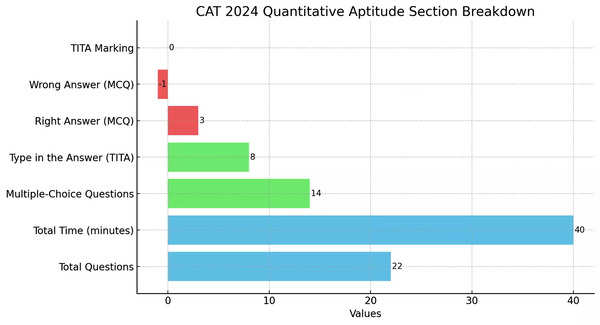
The CAT 2024 is scheduled for November 24, 2024, with Quantitative Aptitude (QA) being a crucial section. Understanding the key topics within this section is vital to maximise scores. The QA section will feature 22 questions, including both multiple-choice questions (MCQs) and Type in the Answer (TITA) questions, with no negative marking for the latter.With a marking scheme that awards +3 for correct answers and -1 for wrong MCQs, this section demands strategic preparation.
As the Common Admission Test (CAT) 2024 approaches, aspiring MBA candidates must prepare diligently to excel in the Quantitative Aptitude (QA) section, a crucial component of the exam. With a total of 22 questions to tackle in just 40 minutes, mastering the essential topics is vital for achieving a high score. This article delves into the high-scoring topics within the Quantitative Aptitude syllabus, providing insights and strategies to help candidates optimise their preparation and maximise their marks on this challenging assessment.
Key Sections in CAT Quantitative Aptitude
The CAT 2024 QA syllabus can be broken down into five major categories: Arithmetic, Algebra, Number Systems, Geometry & Mensuration, and Modern Math. Each of these categories contains high-scoring topics, and a focus on these areas can significantly boost your performance in the exam.

Arithmetic: Foundation for Other Sections
Arithmetic is the most essential topic within the QA section, as it typically accounts for 7-8 questions. Topics such as Percentages, Ratios, Profit & Loss, Simple and Compound Interest, Time, Speed, Distance, and Time & Work are not only crucial in the Quant section but also provide a strong foundation for Data Interpretation and other sections. Since it aligns with real-life applications, arithmetic problems are generally more approachable and can be prepared by practicing a wide variety of question types.
Algebra: Building Blocks of Mathematics
Algebra follows Arithmetic in importance and often comprises 5-6 questions in the QA section. Topics include Linear and Quadratic Equations, Inequalities, and Functions. Algebraic Expressions and Progressions also feature prominently. Although Algebra is seen as slightly more abstract than Arithmetic, it is important to develop a strong understanding of these concepts by revisiting basics and practising problems regularly. Going through past CAT papers is highly recommended to get a feel for the types of Algebra questions asked.
Number Systems: Basic but Important
Number Systems make up 2-3 questions in the QA section. While fewer in number, the questions are often tricky and test a student’s understanding of number theory. Key topics include Factors and Multiples, HCF and LCM, Factorials, and Remainders. It is essential to grasp the basic principles of Number Systems, as they often appear in slightly complex forms. Regular practice of different problem types will make this section less daunting.
Geometry and Mensuration: Conceptual Clarity Required
Geometry, Trigonometry, and Mensuration combine to form another 6-8 questions in CAT QA. Topics like Lines, Angles, Triangles, Circles, and 3D shapes are critical. To perform well in this section, focus on understanding and applying various theorems such as Pythagoras’ and Longest Side Theorem. Begin with basic 2D geometry concepts and then move towards 3D geometry problems. Mensuration problems, particularly those involving surface area and volume, also require strong formula memorisation.
Modern Math: Few but Impactful Questions
Though Modern Math generally contributes only 0-2 questions, its topics—Permutation and Combination, Probability, and Set Theory—are often challenging for students. Even though the probability of encountering these questions is lower, it is still advisable to familiarise yourself with basic concepts as they may appear in both the CAT and other MBA entrance exams (OMETs).
Strategies for CAT Quant Preparation
To excel in CAT 2024 Quantitative Aptitude, aspirants should start by solidifying their understanding of fundamental concepts, particularly in Arithmetic and Algebra. Regular problem-solving practice is key, and previous years’ CAT papers should be reviewed thoroughly to identify recurring question types. Effective time management during the exam is essential, as 40 minutes are allotted for 22 questions. Focus on solving the easier questions first to ensure high accuracy, and leave the more time-consuming problems for later.
By mastering the core topics of Arithmetic, Algebra, and Geometry, and practising regularly, candidates can significantly increase their chances of scoring high in the QA section.




